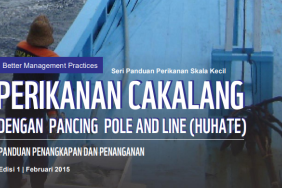#XPDCMBD: "YES, I KNOW WHAT FISH IT IS!"
Author: Estradivari (WWF-Indonesia)
Conducting identification tests on fish species and species that live on the seabed (benthic biota) is a lot of fun! The Sea Team agreed to conduct a fish and benthic biota identification test today (2/11), before making the first dive around the waters of Liran Island and Wetar Island, tomorrow. The test aims to ensure each team member has the same standard of understanding in identifying fish and benthic biota species and estimating their size.
There are various ways of conducting this test. One of them is through the simplest way such as through a powerpoint presentation that displays pictures/photos of a number of fish and benthic biota of different sizes. Then collectively, each member of the team must identify the full name of the species and estimate its size.
We chose a 'temporary classroom' location to carry out this test on the upper deck of the aft Seven Seas ship. Like a race, Tiela (WWF-Indonesia), Ubun (WCS-IP), Begin and Indra (IPB) were eagerly preparing their answers on prepared sheets of paper. With the sea breeze blowing, at 21:00 local time, the test began. The test was divided into four rounds for each category - fish species, benthic biota species including coral species, and fish size - with 20 images/photos each. Each team member had to be able to write down the identification results per picture/photo within ten seconds.
"Yes, I know what that fish is!"
"Ouch, I forgot the Latin name of that fish!"
"Ah, I just learned that type of coral this morning, but now I've forgotten."
"Duh, I'm not good at predicting the size of big fish."
These were some of the comments made by members of the Sea Team during the test. None of the members felt under pressure while taking the test. We always discussed the answers together after each round. Participants were also asked to judge their own answers. There is no punishment if a participant makes a mistake, as the test is serious but relaxed, while still providing capacity building. Through this test, team members learn together about species they have never encountered before or just to remind them of the names of species they already know.
This identification test will be more useful if it is supported by direct identification tests in the field. Together we decided that, on the first dive, the team would jointly explore the identification of fish species and benthic biota underwater, while establishing the teamwork patterns that would be used during this expedition.





